
West Bromwich is a market town in the borough of Sandwell, West Midlands, England. Historically part of Staffordshire, it is 7 miles northwest of Birmingham. West Bromwich is part of the area known as the Black Country, in terms of geography, culture and dialect. West Bromwich had a population of 103,112 in the 2021 Census.
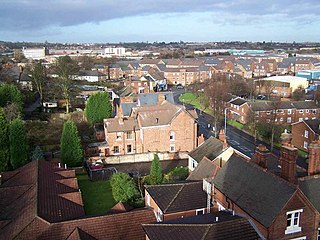
Tipton is an industrial town in the Metropolitan Borough of Sandwell in the West Midlands County in England. It had a population of 38,777 at the 2011 UK Census. It is located northwest of Birmingham and southeast of Wolverhampton. It is also contiguous with nearby towns of Darlaston, Dudley, Wednesbury and Bilston.

Smethwick is an industrial town in Sandwell, West Midlands, England. It lies 4 miles (6 km) west of Birmingham city centre. Historically it was in Staffordshire and then Worcestershire before being placed into then West Midlands County.
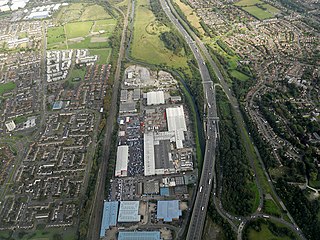
Castle Bromwich is a village and civil parish in the Metropolitan Borough of Solihull in the West Midlands, England. It borders the rest of the borough to the south east, Sutton Coldfield to the east and north east, Shard End to the south west, Castle Vale, Erdington and Minworth to the north and Hodge Hill to the west.

Boscobel House is a Grade II* listed building in the parish of Boscobel in Shropshire. It has been, at various times, a farmhouse, a hunting lodge, and a holiday home; but it is most famous for its role in the escape of Charles II after the Battle of Worcester in 1651. Today it is managed by English Heritage.

Mead Art Museum houses the fine art collection of Amherst College in Amherst, Massachusetts. Opened in 1949, the building is named after architect William Rutherford Mead, of the prestigious architectural firm McKim, Mead & White. His wife, Olga Kilyeni Mead, left her entire estate to Amherst College. The museum, a member of Museums10, is free and open to the public.

Compton Verney House is an 18th-century country mansion at Compton Verney near Kineton in Warwickshire, England. It is located on the west side of a lake north of the B4086 about 12 miles (19 km) north-west of Banbury. Today, it is the site of the Compton Verney Art Gallery.

Upsall Castle is a fourteenth-century ruin, park and manor house in Upsall, in the Hambleton district of North Yorkshire, England.
West Bromwich Permanent Building Society is a British building society, commonly called "the West Brom".

West Bromwich Town Hall is a municipal building in West Bromwich, West Midlands, England. It is a Grade II listed building.
Greets Green is a residential area of West Bromwich in the West Midlands of England. The appropriate Sandwell ward is called Greets Green and Lyng. The population taken at the 2011 census was 11,769. It was mostly developed between 1920 and 1970 with a mix of private and council housing, though there are still buildings in the area which date from before the First World War. A lot of the older housing in the area has been procured by development companies and have been knocked down or are ready to be knocked down to make way for more modern housing.
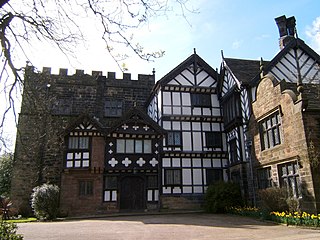
Turton Tower is a manor house in Chapeltown in North Turton, Borough of Blackburn with Darwen, Lancashire, England. It is a scheduled ancient monument and a Grade I listed building.

Barrells Hall is a large house in the Warwickshire countryside near Henley-in-Arden. The nearest village is Ullenhall, which for many years was the estate village, large parts of it having been built by the owners of Barrells Hall, the Newtons, one of the families who formerly owned Barrells. An adjacent house named Barrells Park was built in about 1950 on part of the Barrells estate.
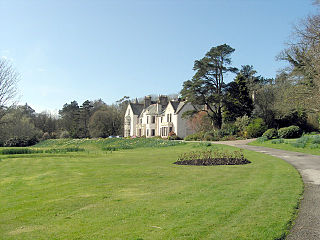
Achamore House is a mansion on the Isle of Gigha, Scotland. It was built in 1884 for Lt-Col William James Scarlett, and the extensive gardens were laid out by Sir James Horlick from 1944. The house is protected as a category B listed building, while the grounds are included in the Inventory of Gardens and Designed Landscapes in Scotland.
Reuben Farley was an English businessman, politician and philanthropist. He was the first Mayor of West Bromwich and served for four terms. He was also the first freeman of West Bromwich and the town's Farley Clock Tower stands in his honour.
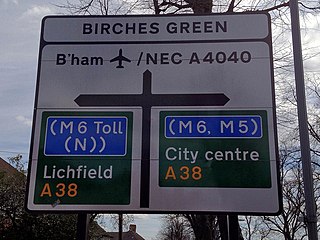
Birches Green is a small area of Tyburn in Birmingham, England, within the parliamentary constitiuency of Erdington. It is located between Gravelly Hill, Erdington and the M6 motorway.

Oakes Park is a privately owned, historic park land in the green-belt area of south Sheffield. It contains 15 private homes as well as a 17th-century English country house which now operates as The Oakes Holiday Centre, a Christian, residential activity centre for young people between the ages of 8 and 18. It is set in extensive grounds which make it very difficult to be seen by the general public. It is situated on Norton Lane in the suburb of Norton within the City of Sheffield in England. The house is a Grade II* listed building, as are several other buildings and features.

Caludon Castle is a Scheduled Ancient Monument and Grade I listed building in Coventry, in the West Midlands of England. A second moated site 190 metres (620 ft) to the south is a Scheduled Ancient Monument in its own right. The castle is now a ruin, and all that remains is a large fragment of sandstone wall. What remains of the estate is now an urban park, owned and run by Coventry City Council, but much of it was sold and developed into housing estates in the early 20th century.

Bromwich Hall - The Manor House Museum is an important, Grade I listed, medieval domestic building built by Richard de Marnham around 1270 as the centre of his agricultural estate in West Bromwich.

Horsforth Hall Park is a large community park in Horsforth, West Yorkshire, England, approximately six miles from Leeds city centre.

















